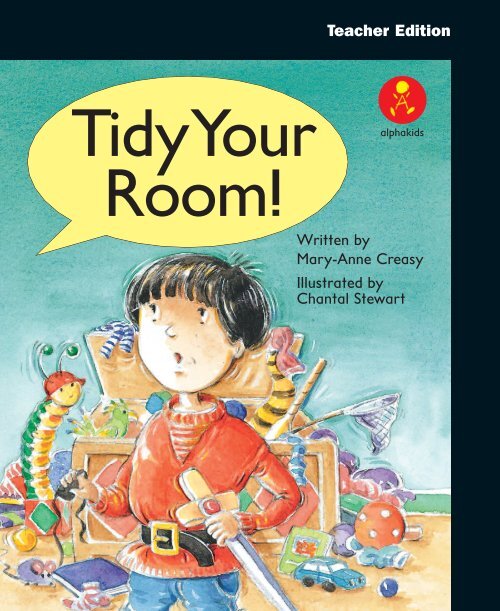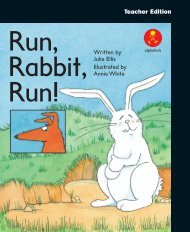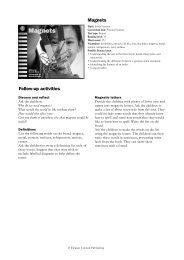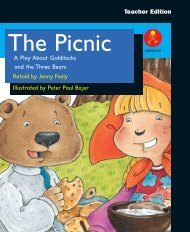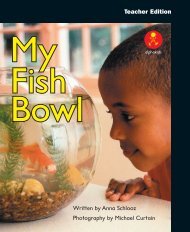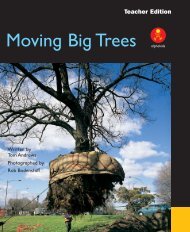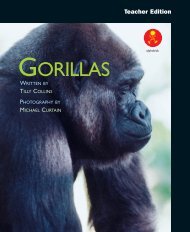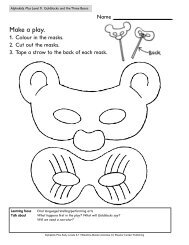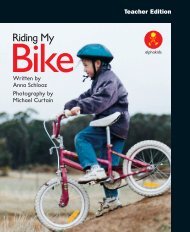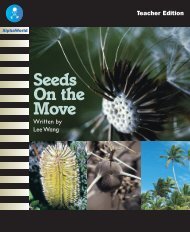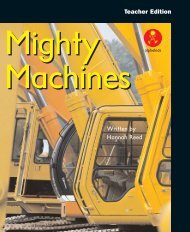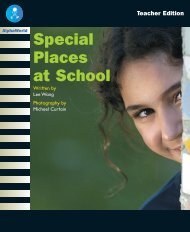Tidy Your Room
Tidy Your Room
Tidy Your Room
Create successful ePaper yourself
Turn your PDF publications into a flip-book with our unique Google optimized e-Paper software.
Teacher Edition<br />
<strong>Tidy</strong><strong>Your</strong><br />
alphakids<br />
<strong>Room</strong>!<br />
Written by<br />
Mary-Anne Creasy<br />
Illustrated by<br />
Chantal Stewart
Published edition<br />
© Eleanor Curtain<br />
Publishing 2004<br />
First published 2004<br />
Apart from any fair dealing for<br />
the purposes of study, research,<br />
criticism or review, as<br />
permitted under the Copyright<br />
Act of Australia, no part of this<br />
book may be reproduced by<br />
any process, or transmitted in<br />
any form, without permission<br />
of the copyright owner. Where<br />
copies of part or the whole of<br />
this book are made under Part<br />
VB of the Copyright Act, the<br />
law requires that records of<br />
such copying be kept and the<br />
copyright owner is entitled to<br />
claim payment.<br />
Developed by<br />
Eleanor Curtain Publishing<br />
Text: Nicole Di Marco<br />
Consultant: Susan Hill<br />
Designed by<br />
Alexander Stitt<br />
Production by<br />
Publishing Solutions<br />
Printed in China<br />
ISBN 0 7253 3397 9<br />
1 2 3 4 5 6 7 8 9<br />
04 05 06<br />
?<br />
How to use this book<br />
Before reading: Talkthrough<br />
Talk through the book with the children. Encourage<br />
them to predict the text from the cover and the<br />
pictures, and to think about the information they<br />
provide. Direct the children’s attention to aspects of<br />
the text that may challenge them. Support the children<br />
to deal with these challenges by asking the<br />
Talkthrough questions on each page.<br />
During reading: Observe and support<br />
Observe the children as they read. Encourage them<br />
to monitor their own reading as they comprehend<br />
the text. As needed, support the children by helping<br />
them to discover and use reading strategies and cues<br />
to solve problems and respond to reading challenges<br />
that arise in the text. Interruptions to the children’s<br />
reading should be minimal and focused on specified<br />
learning needs.<br />
After reading: Comprehension, returning to<br />
the text, responding and writing links<br />
To further develop children’s understanding of the<br />
text, select from activities found on page 16 and the<br />
inside back cover. These whole text, sentence and word<br />
level activities reinforce the teaching focus of this<br />
book. Assessment ideas are provided to assist with<br />
planning for further teaching.<br />
Text highlights<br />
• The use of direct speech.<br />
• The text is repetitive, with up to eight<br />
lines of text on a page.<br />
Vocabulary<br />
better, bookshelf, clothes, cupboard,<br />
everywhere, great, opened, pirate, shut, tidy
Setting the context<br />
Encourage the children to talk about<br />
bedrooms and tidiness.<br />
Does your bedroom ever get really messy?<br />
Why?<br />
Who tidies it up?<br />
Do you like having a tidy bedroom? Why?<br />
Introducing the book<br />
Give each child a copy of the book.<br />
This book is called <strong>Tidy</strong> <strong>Your</strong> <strong>Room</strong>! It is<br />
about how one boy tries to tidy his room.<br />
<strong>Tidy</strong><strong>Your</strong><br />
<strong>Room</strong>!<br />
alphakids<br />
Written by<br />
Mary-Anne Creasy<br />
Illustrated by<br />
Chantal Stewart<br />
<strong>Tidy</strong> <strong>Your</strong> <strong>Room</strong>!<br />
Written by Mary-Anne Creasy<br />
Illustrated by Chantal Stewart<br />
HORWITZ<br />
MARTIN<br />
EDUCATION<br />
Front cover<br />
What do you notice about the boy’s<br />
bedroom?<br />
Point out that the title is enclosed in a<br />
speech bubble.<br />
Who could be saying, ‘<strong>Tidy</strong> your room!’?<br />
Title page<br />
What is this picture of? Does it give you<br />
any clues about the story?<br />
Point out the names of the author and<br />
illustrator.
<strong>Tidy</strong> <strong>Your</strong> <strong>Room</strong> Pages 2–3<br />
?<br />
Talkthrough<br />
What can you tell about the boy’s room from this picture?<br />
Point to the exclamation mark.<br />
An exclamation mark tells us to read with a lot of expression.<br />
Read the sentence with a lot of expression.<br />
Can you read it like me?<br />
Observe and support<br />
Can the children identify an exclamation mark and<br />
explain why it is used?<br />
Can you show me an exclamation mark? What does it tell you?<br />
2
My room was messy!<br />
Things were everywhere.<br />
‘You can go out to play<br />
when your room is tidy,’ said Mum.<br />
2 3<br />
3
<strong>Tidy</strong> <strong>Your</strong> <strong>Room</strong> Pages 4–5<br />
?<br />
Talkthrough<br />
Model the language of the text.<br />
Look, the boy has put all his books, all his toys and all his<br />
clothes in the cupboard, and shut the doors. Does everything fit<br />
in the cupboard? How can you tell?<br />
Relate the story to the children’s own experiences.<br />
Have you ever tidied up like this?<br />
Observe and support<br />
Can the children use the illustrations to infer meaning<br />
from the text?<br />
What do you think might happen when someone opens the<br />
cupboard?<br />
4
I put all my books<br />
and all my toys<br />
and all my clothes<br />
in the cupboard.<br />
I shut the doors.<br />
4<br />
5<br />
5
<strong>Tidy</strong> <strong>Your</strong> <strong>Room</strong> Pages 6–7<br />
?<br />
Talkthrough<br />
Continue modelling the language of the text.<br />
Mum comes in and says, ‘What a tidy room’. But then she<br />
opens the cupboard. What happens?<br />
Check that children can identify the high-frequency<br />
word ‘my’ in the text.<br />
Can you find the word ‘my’? Can you see it again?<br />
Observe and support<br />
Can the children use their knowledge of letter-sound<br />
relationships to support their reading? If a child has<br />
difficulty with a word, ask the following questions.<br />
What letter does that word start with? What sound might it<br />
make? Can you think of a word that starts with / / that would<br />
fit there?<br />
6
Mum came in.<br />
‘What a tidy room,’<br />
she said.<br />
Then she opened<br />
my cupboard.<br />
All my books fell out.<br />
All my toys fell out.<br />
All my clothes fell out.<br />
6<br />
7<br />
7
<strong>Tidy</strong> <strong>Your</strong> <strong>Room</strong> Pages 8–9<br />
?<br />
Talkthrough<br />
Give the children the opportunity to construct the<br />
meaning of the text for themselves.<br />
Read page 8 and tell me what Mum said.<br />
Confirm what the text says.<br />
Yes, she says, ‘Oh dear’ and ‘You can do better than that’.<br />
Look at the picture on page 9. What is the boy putting in his toy<br />
box? Do you think this will work better?<br />
Observe and support<br />
Can the children read the text with expression?<br />
How would Mum be feeling? What might her voice sound like?<br />
Can you make your voice sound like that when you read?<br />
8
8<br />
‘Oh dear,’ she said.<br />
‘You can do better than that.’<br />
So I put all my books on the bookshelf.<br />
I put all my toys and all my clothes<br />
in the toy box.<br />
9<br />
9
<strong>Tidy</strong> <strong>Your</strong> <strong>Room</strong> Pages 10–11<br />
?<br />
Talkthrough<br />
Provide opportunities for the children to predict what<br />
will happen.<br />
Why is the boy sitting on the box? What happens when he<br />
jumps off it?<br />
Focus on the detail in the illustrations.<br />
What is the boy wearing? Was he dressed like this at the start?<br />
What might he put on next? Why?<br />
Observe and support<br />
Do the children search for a range of information on<br />
the page to support their reading?<br />
When you looked at the pictures before you read the text, what<br />
were you looking for? How did that help you? What else did you<br />
check?<br />
10
I sat on the lid of my toy box.<br />
Mum came in.<br />
‘What a tidy room,’ she said.<br />
I jumped off my toy box.<br />
All my toys fell out.<br />
All my clothes fell out.<br />
10 11<br />
11
<strong>Tidy</strong> <strong>Your</strong> <strong>Room</strong> Pages 12–13<br />
?<br />
Talkthrough<br />
Ask the children to confirm or amend their earlier<br />
predictions and make new ones.<br />
What does Mum say about the boy’s room this time?<br />
How will the boy solve the problem? Can you tell from the<br />
picture what he will do next?<br />
Observe and support<br />
Do the children understand the inferences in the text?<br />
Why do all the boy’s things need to go back to the right place?<br />
12
‘Oh dear,’ she said.<br />
‘You can do better than that.’<br />
So I put all my toys in the toy box<br />
and all my clothes in the cupboard.<br />
12 13<br />
13
<strong>Tidy</strong> <strong>Your</strong> <strong>Room</strong> Pages 14–15<br />
?<br />
Talkthrough<br />
Mum comes in. What do you think she says?<br />
What is the boy dressed up as? What does he need now?<br />
Observe and support<br />
Can the children read the text fluently?<br />
I liked the way you read this. It made it easy for me to<br />
understand.<br />
14
Mum came in.<br />
My room was tidy.<br />
‘That’s great!’ she said.<br />
‘You can go out and play now.’<br />
‘Okay!’ I said.<br />
‘But I need my pirate ship.’<br />
14<br />
15<br />
15
<strong>Tidy</strong> <strong>Your</strong> <strong>Room</strong> Page 16<br />
? Talkthrough<br />
What is the boy doing now?<br />
How do you think his mother is feeling?<br />
What do you think will happen next?<br />
16<br />
16<br />
After reading<br />
Being a meaning maker<br />
Encourage the children to support their responses<br />
with evidence from the book as they discuss these<br />
comprehension questions.<br />
What does the boy have to do before he can go out to play?<br />
Where does he put everything at first?<br />
Where does he have to put things to make his room tidy?<br />
Why does the boy say he needs his pirate ship?
Being a code breaker<br />
• High-frequency words: a, can, go, I,<br />
in, is, my, of, on, said, she, the, to,<br />
was, were, you.<br />
• Words that rhyme with ‘play’: bay,<br />
day, gay, hay, lay, may, pay, ray, say,<br />
stay, tray, way.<br />
Being a text user<br />
Refer to the text when discussing these<br />
questions:<br />
What does this book teach you about<br />
tidying up?<br />
Do you think the boy should have to tidy<br />
up his room? Why or why not?<br />
Being a text critic<br />
What does this author think about boys?<br />
Are all boys like this?<br />
Responding to text<br />
Ask the children to work in<br />
cooperative groups to retell the<br />
text as a soundscape. Encourage them to<br />
make a range of sounds to represent each<br />
of the actions in the book; for example, ‘I<br />
shut the doors’ (bang two pieces of wood<br />
together); ‘All my books fell out’ (clap<br />
hands rapidly).<br />
Make a simple board game that<br />
incorporates language from the<br />
book. The children could take turns to<br />
move around the board, responding to<br />
the instructions. These could include<br />
things such as: All my clothes fell out —<br />
Move back 2 spaces. What a tidy room —<br />
Move forward 3 spaces.<br />
Children could use magnetic<br />
letters to make words with the<br />
rhyme ‘play’: bay, day, hay, lay, may, pay,<br />
ray, say, stay, tray, way.<br />
Writing<br />
The children could work with a partner<br />
to make labels for classroom equipment<br />
to help their classmates at pack-up time.<br />
The children could write about their own<br />
experiences tidying their bedrooms.<br />
Assessment<br />
Can the children:<br />
• explain why the boy had trouble getting his room tidied up?<br />
• read the text fluently and with expression?<br />
whole text activity sentence activity word activity
alphakids<br />
<strong>Tidy</strong><strong>Your</strong><br />
<strong>Room</strong>!<br />
Written by<br />
Mary-Anne Creasy<br />
Illustrated by<br />
Chantal Stewart<br />
Teacher<br />
Edition<br />
Other<br />
books<br />
at this<br />
level<br />
Hiding<br />
in the Sea<br />
Written by Sarah Smith<br />
alphakids<br />
Topic: Family life<br />
Curriculum link: SOSE<br />
Text type: Narrative<br />
Reading level: 8<br />
Word count: 190<br />
High-frequency words: a, can, go, I, in, is, my, of,<br />
on, said, she, the, to, was, were, you<br />
Vocabulary: better, bookshelf, clothes, cupboard,<br />
everywhere, great, opened, pirate, shut, tidy<br />
Possible literacy focus<br />
Discussing the use of illustrations to develop the<br />
story line.<br />
Interpreting the text: Why did the boy have so much<br />
trouble tidying up his room?<br />
Lizard’s Tail<br />
The<br />
alphakids<br />
Written by Mark Gagiero<br />
Illustrated by Kelvin Hucker<br />
Train Race<br />
Written by Marilyn Woolley<br />
Photography by Michael Curtain<br />
alphakids<br />
TheCatand the<br />
Mouse<br />
Retold by Julie Ellis<br />
Illustrated by<br />
Naomi C. Lewis<br />
Mammals<br />
Written by Hannah Reed<br />
alphakids<br />
alphakids<br />
Summary<br />
This book is about a boy trying to tidy up his room<br />
before he goes out to play.<br />
ISBN 0- 7253- 3397- 9<br />
9 780725 333973<br />
alphakids


